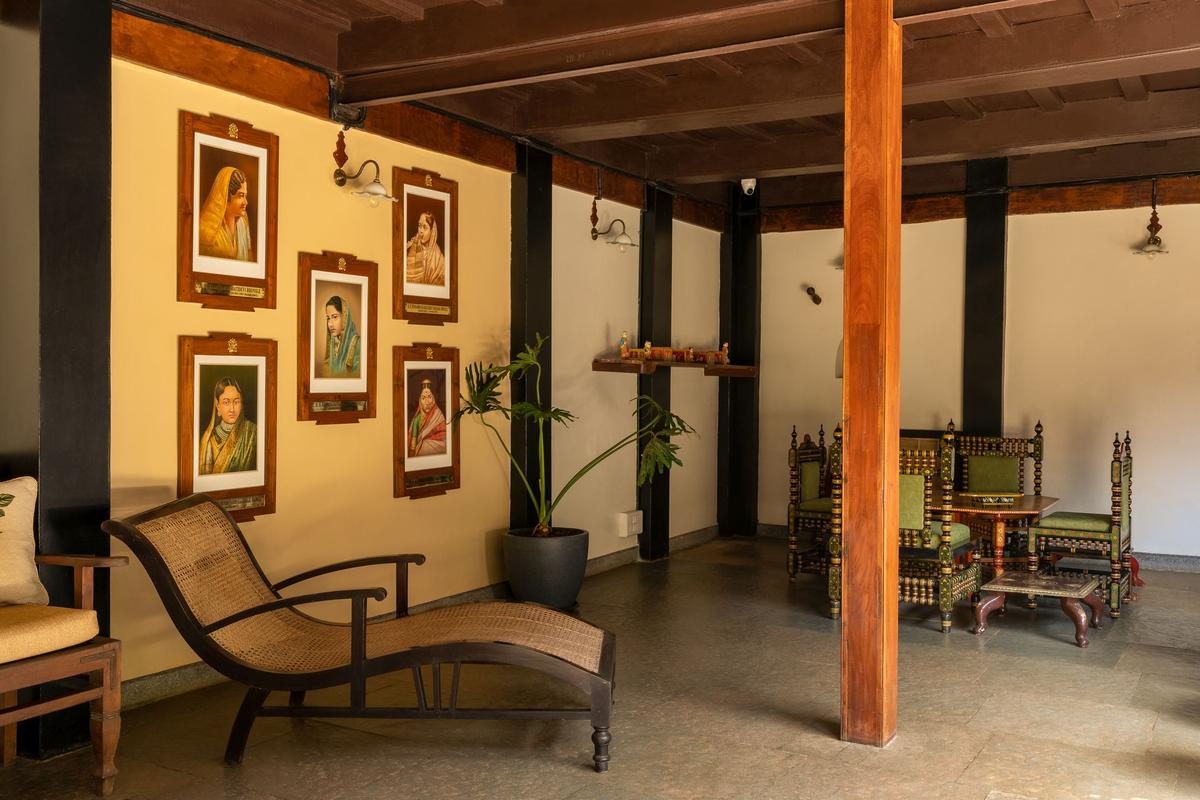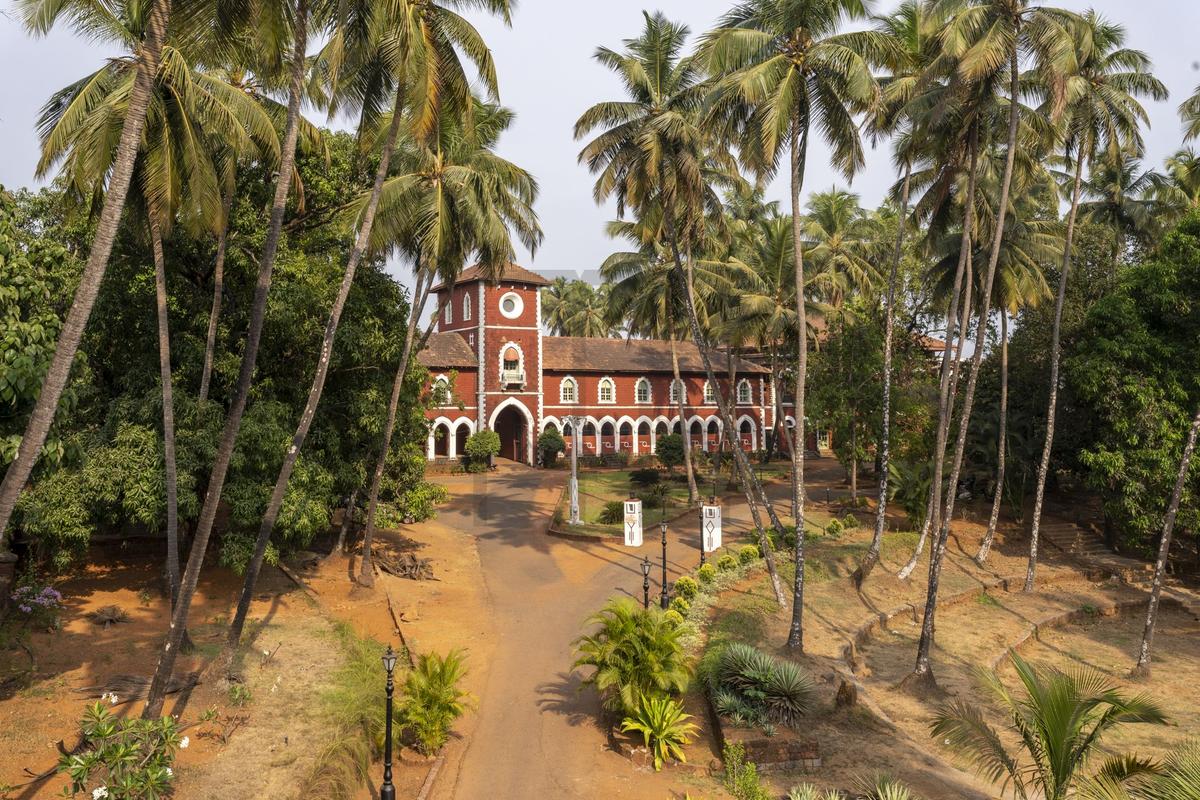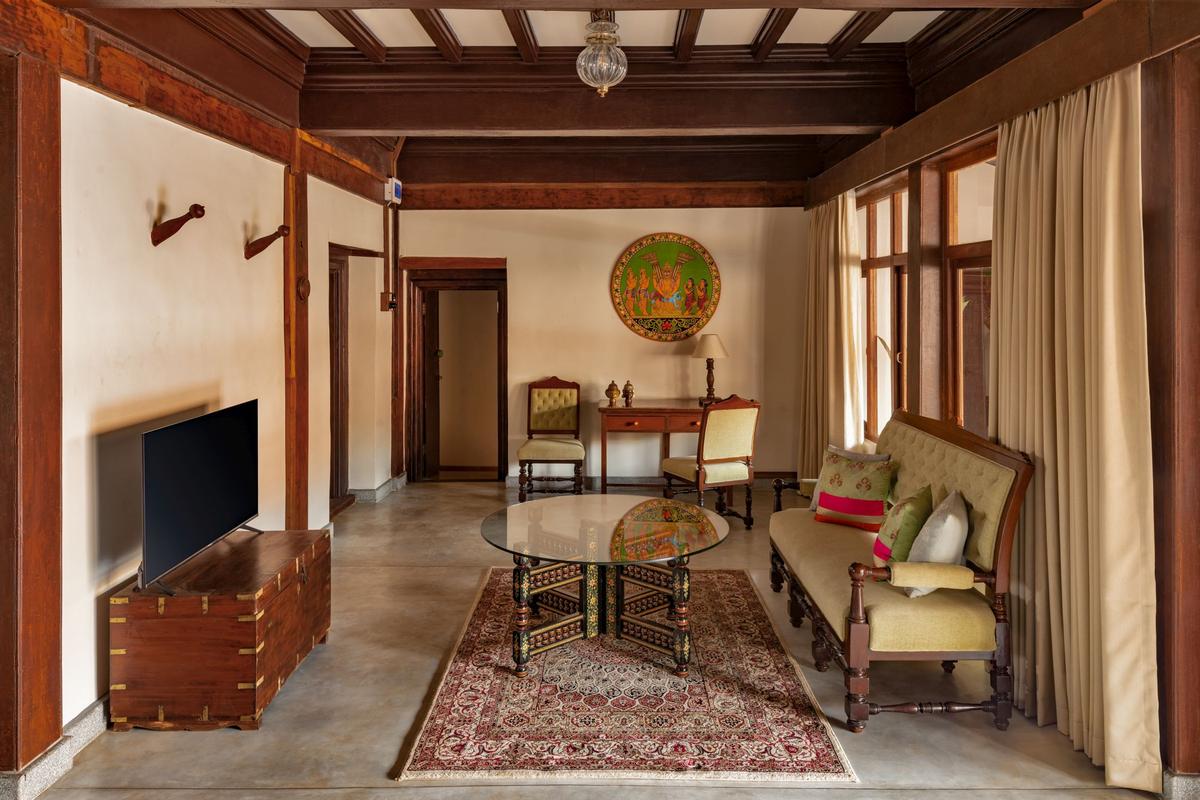No matter how blasé one is, there is no denying the thrill of staying in a palace. The Sawantwadi Palace Boutique Art Hotel is just a 40-minute drive from Goa’s gleaming new Manohar International Airport.
Sanjay, the driver, pointed at the palace as we approached, giving me a Malory Towers moment with gracious English arches segueing seamlessly with warm-red laterite stone, creating an impression of sturdy elegance nestled in the foothills of the Sindhudurg Range. The palace was built by Khem Sawant III between 1755 and 1803.
Shraddha Lakham Sawant Bhonsle at work
| Photo Credit:
Special Arrangement
Before meeting our hosts, Lakham Khem Sawant Bhonsle and his wife, Shraddha, we are greeted by Sushi, the golden retriever. Shraddha and Lakham both trained at the Culinary Institute of America (CIA), where they first met.
“He was my first friend at CIA,” Shraddha, 34, confides with a warm grin. While she specialises in Japanese and Korean cuisine, Lakham, also 34, is a trained baker and pastry chef who veers to the sweet side.
It was during their wedding celebrations in 2019 that the idea of transforming Taisaheb Wada, the palace wing dedicated to the strong women of the family, into a boutique hotel first took root. Since then, it has been a labour of love for the royal couple to bring their vision of a six-room, exquisitely appointed hotel to life.

Sawantwadi Palace Boutique Art Hotel
| Photo Credit:
Mohith Rai Srivastav
After a delicious lunch — an artfully arranged brass thali featuring local delicacies like white chawli usal, Maharashtrian varan kaju kurma, potato bhaji, solkadhi, raw banana fry, and the fluffiest ghavne — we set off for a tour of the museum and darbar hall. The photos and artifacts offer a glimpse into life in the before times, including Sati Stones and Warrior stones. “We also have a Second Century Buddha statue in our collection,” Shraddha says.
A throne made in the 1940s for Rajesaheb Shivram Sawant Bhonsle’s coronation takes pride of place in Darbar Hall. Behind the throne, is a bust of Queen Victoria, which was given to all the Princely states that came under the British Raj on her 75th birthday. The large pots in the Darbar Hall, Shraddha says, came from the Baroda Gaikwad family with the princesses who married into the family.
Beyond the food, which is predictably exceptional, courtesy of Shraddha and Lakham, the hotel is also a sanctuary for ganjifa art and lacquerware. Ganjifa, as Wikipedia helpfully explains, is a card game brought to India by the Mughals. The real artistry lies in the intricate paintings on the cards, which was adapted in the Indian context.
The hotel too carries the Ganjifa theme into its design.
Shraddha says her interest in the art form blossomed after her marriage. “My in-laws have been patrons since the 16th Century, and my grandparents-in-law, Rajmata Satvashiladevi Bhonsle and Rajesaheb Shivram Sawant Bhonsle, revived it in 1971.”

First view of Sawantwadi Palace Boutique Art Hotel
| Photo Credit:
Mohith Rai Srivastav
Though Satvashiladevi passed away in 2018 shortly after Shraddha’s engagement with Lakham, she discovered the late Rajmata’s ganjifa room. “During the pandemic, when there wasn’t much to do, being the Bombay girl I am, I took on sorting the room as a project.” Cleaning and cataloguing the items became an eye-opener, she says, while adding, “Just going through the articles, the files, the exhibition notes, and seeing the collection of ganjifa cards, something clicked. I was intrigued.”
At the hotel, guests can try their hand at ganjifa card painting workshops (I did, with middling success!) and participate in card-playing sessions. The hotel shop offers ganjifa card sets priced between ₹10,000 and ₹14,000, as well as art-inspired buttons, coasters, trays, and jewellery — perfect for those who prefer collecting to playing.
Shraddha’s mother-in-law, Shubhada, who graduated from the JJ School of Arts, discovered ganjifa art only after her marriage. “I didn’t know anything about the art form,” she confides over an exquisite high tea of focaccia parmesan sandwiches, double chocolate cookies, and assorted dainties. “My in-laws dealt with collectors abroad. I was fascinated by the history of the cards — they were so attractive, and one could learn so much mythology through them.”
The game, Shubhada explains, is more than just entertainment. Besides testing memory, it helped preserve traditional knowledge. “It’s not gambling. In fact, saying the name of God while playing is believed to remit sins!” Ganjifa cards from across India — Mysore, Nirmal, Rajasthan and Odisha — reflect distinct artistic styles. Sawantwadi Ganjifa, Shraddha notes, stands apart. “The art form and the game were introduced in Sawantwadi by people from Telangana and Andhra who migrated here to study under King Khem Sawant III.”

A room at the Sawantwadi Palace Boutique Art Hotel with the King card
| Photo Credit:
Mohith Rai Srivastav
The stories depicted on the cards vary, according to region and belief system. “In Sawantwadi, we follow Vishnu, so our Ganjifa cards are based on the 10 incarnations of Lord Vishnu,” Shraddha explains. The Sawantwadi sets are known for their vibrant colours — lemon yellow, mehndi green, and sindhuri (a bright orange). “The deities’ movements are subtle. They wear pearls around their necks and nauvari saris.” In contrast, Odisha’s Ganjifa cards depict deities with more expansive gestures. “Their eyes are larger, outlined with kajal, unlike the dainty-eyed deities of Sawantwadi. Odisha uses darker tones — brown, maroon, black, while Jaipur’s Ganjifa features baby pink, blue, and gold.” The number of cards also varies. “The Dashavatar Ganjifa is a 120-card game. The Dhanalakshmi set, based on the avatars of Goddess Lakshmi, has 108 cards. The Rashi Ganjifa, based on zodiac signs, includes 144 cards,” she explains.
Each of the hotel’s six rooms is inspired by avatars of Vishnu — Matsya, Kurma, Varaha, Narsimha, Vamana, and Parashuram. “Everything in the Matsya room, for instance, from the doorknobs to the bathroom mirrors and study tables, reflects the avatar’s theme and are all done in-house,” Shraddha says. “The Matsya room has a light-blue wall with a five-foot painting of the Matsya king card.” I stayed in the Vamana room, where even the key ring and coasters were Vamana-themed, and a stunning painting of the Vamana king card adorned the wall.
Securing a Geographical Indication (GI) tag for Sawantwadi Ganjifa was a major milestone. “We applied at the end of 2021 and were granted the GI tag in January 2023. It gives our artisans an official stamp of authenticity and access to various benefits.”
We collaborated with artisans creating ganjifa-themed jewellery and a designer working on bridal wear inspired by the art. “We’re also tying up with small shops in Goa and Mumbai, conducting workshops in colleges interested in art, and collaborating with institutions including NIFT and B.S. Bandekar College of Fine Art in Sawantwadi. We encourage students to intern with us, explore the art form, and apply it in new ways.”
The next big goal? Expanding the museum to showcase their growing collection. “We’ve acquired the largest collection of ganjifa and playing cards from across India,” Shraddha says.
The hotel also offers curated experiences such as a picnic at Amboli Ghats, visits to Shiroda or Vengurla beaches, a walk through Sawantwadi village and a puppet performance at Pinguli village.
To reserve a room, mail info@sawantwadipalace.com or call +91 7498488318
The writer was at the Sawantwadi Palace Boutique Art Hotel at the invitation of the hotel

